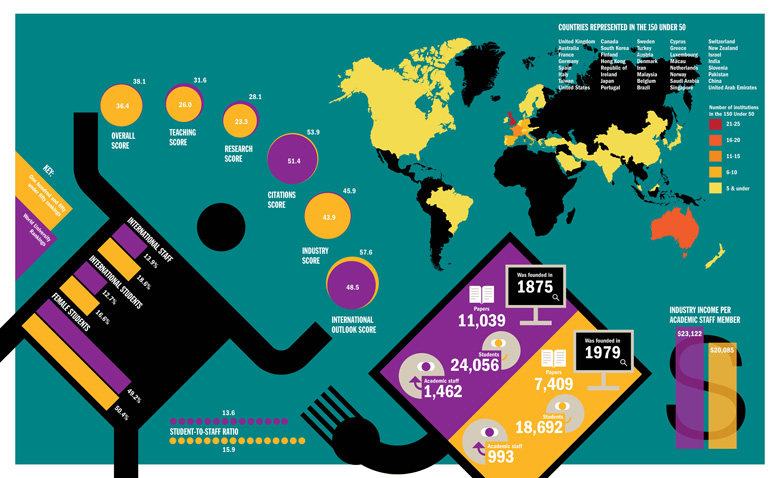Browse the full list of the world's top 150 universities under 50 years old
“Traditions can be obstructive if universities’ existence is only justified because they have always been there,” says Ulrich Rüdiger, rector of the University of Konstanz. “Young universities cannot benefit from these structures that have evolved over long periods, often centuries, but they are not bound by them either.”
Rüdiger’s words sum up the success of the institutions that feature in the Times Higher Education 150 Under 50 Rankings 2016. While the world’s top ancient universities have centuries of funding, alumni and reputation, they “tend to isolate themselves and take on a life of their own, which is not conducive to academic dialogue”, he notes. Young universities, in comparison, are generally “much smaller and more flexible”.
He says that many of the core strategies that have been implemented at the University of Konstanz, which is seventh in this year’s ranking of the world’s best universities under 50 years old, would not be possible at older institutions. One example he cites is the university’s performance-based funding system, in which professors receive no basic funding but are instead required to submit an annual progress report. This is reviewed by members of a committee of professors at the institution who then allocate funding.
“If you receive a reasonable amount of money every year, there is no pronounced willingness to ask yourself whether the [research] you are doing is modern and interesting to other people. But when you have to write a yearly progress report, you must convince a committee of 12 colleagues from other disciplines at the university that what you are doing is right and ambitious and up to date,” he says.
“Other well-established universities don’t have this [strategy] because they were founded centuries earlier, with a completely different mission statement and understanding.”
He also points to his university’s campus location, which facilitates interdisciplinary teaching and research; its “medium” size, which allows flat hierarchies and high levels of communication and innovation; and its Centre for Young Researchers, which gives postdoctoral scholars the independence and funding to run their own research groups, as further key assets.
But Konstanz is not the only German institution to do well in this ranking. Nine of the country’s universities make the top 100, including three others in the top 20: the Karlsruhe Institute of Technology at eighth, Ulm University at 13th and the University of Duisburg-Essen at 17th.
France has 11 representatives in the top 100, led by Pierre and Marie Curie University (ninth).
Jean Chambaz, its president, says that the French government used to control each university’s budget, but that there has been “increased autonomy” since 2009, which has enabled the institution to “restructure our laboratories, encourage transdisciplinary projects, increase the internationalisation of research careers, and create a department to improve tech transfer”.
Meanwhile, his university used the French government’s Investing for the Future Programme – launched in 2009 and designed to boost French competitiveness by investing in research and higher education – as an opportunity to create the Sorbonne University group, an alliance of 11 higher education or research institutions that offer new academic and research programmes.
150 Under 50 Rankings 2016 by the numbers
How the young universities compare with those in the World University Rankings 2015-2016
On the teaching side, interdisciplinary relations allow students to customise their own degree within a major-minor system.
“Programmes can combine, for example, science and Chinese for those who envision working in an international setting, or art history and chemistry to unlock the knowledge of the creation of ancient artwork, its preservation and restoration,” he says. “This opportunity to customise studies is the best guarantee that students will be prepared for future professions.”
The UK, the world’s best represented nation in the 150 Under 50 ranking, matches France with 11 institutions in the top 100, led by the University of Dundee (16th).
Sir Peter Downes, Dundee’s vice-chancellor, says that the results prove that the UK’s ancient universities “do not have a monopoly on excellence”.
“Younger institutions, with the support of government and other funders, have been able to create their own areas of strength, life sciences at Dundee being an excellent example,” he says. “From a small biochemistry department in a converted horse stables in the mid-1970s, we have built one of Europe’s largest research institutions, housing over 900 scientists from over 60 countries.”
Hans de Wit, director of the Center for International Higher Education at Boston College, says that universities in the UK, France and Germany do particularly well in this ranking because they are in the “slipstream of the top universities” within “very stable and large higher education systems” and many of them are close to their 50th birthday.
“They benefit from the reputation of the top universities – they get more international students, they get the second layer of good scholars, they get funding, and they have more possibilities to co-publish,” he says.
De Wit adds that Spain, in comparison, also has several new universities (four make the top 100) but these generally appear lower down in the league table because “the reputation and stability of the Spanish higher education system is far less great”.
Despite Europe’s overall success in the list, the top places are dominated by institutions in the Asia-Pacific region. While Switzerland’s École Polytechnique Fédérale de Lausanne takes pole position and the Netherlands’ Maastricht University is fourth, Singapore’s Nanyang Technological University, Hong Kong University of Science and Technology and South Korea’s Pohang University of Science and Technology (Postech) fill the remainder of the top five slots. South Korea is Asia’s most-represented nation in the top 100, with four institutions.
However, the big winner in the Asia-Pacific region, and the most-represented nation in the top 100, is Australia. Although the country has no representatives in the top 20, it claims 16 universities in the top 100, with half of these sitting in the top 50.
Claim a free copy of the full 150 Under 50 Rankings 2016 digital supplement
Hamish Coates, professor of higher education at the University of Melbourne, points to a host of reasons why Australia’s young universities are so successful: the country has a national approach to higher education, competing against the rest of the world rather than internally; it “got rid of the British class structure” meaning that higher education is “open to everyone”; and its location attracts staff and students from across Asia.
He compares Australia’s higher education success with its achievements in the wine industry – perhaps a fitting analogy following the appointment earlier this year of Nobel laureate and vineyard-owner Brian Schmidt as vice-chancellor of the Australian National University.
“Over the past 20 or 30 years we have made the best wine industry on earth. And we’ve done exactly the same thing with higher education,” he says.
Peter Coaldrake, vice-chancellor and president of Queensland University of Technology (QUT) (joint 28th), adds that Australia’s higher education system “does not favour younger institutions, but its competitive funding mechanisms for student demand and research allow Australian institutions to compete in ways that allow them to utilise individual strengths while navigating their particular challenges”.
“The older, more established institutions have the benefit of history and a research track record, but tend to perform worse in terms of inclusion metrics and have very mixed results in various surveys, metrics and awards related to teaching capability and learning support,” he says.
“Some of the most established institutions in Australia have recently argued for a greater slice of future research funds on the basis of research share, which is strongly correlated with age of institution. Efforts by those institutions to monopolise these funds suggest they recognise that newer institutions, particularly Australia’s ATNs [Australian Technology Network of Universities], are rising rapidly in outputs and reputation and, over time, may disrupt the existing order in Australian higher education.”
Coaldrake adds that it is vital that newer universities create their own strategies and niches, rather than try to emulate neighbouring elite universities.
“The reputations of many prestigious institutions have often benefited from research success that can be traced back through previous generations of scholars and achievers. But the interconnections and pace of change in the modern world mean that any institution can rapidly lose relevance and value if that institution does not contribute solutions to meaningful, real-world challenges,” he says.
“It is unwise to take on the older players at their own game, that is, via stand-alone discipline-based research. Younger universities need to carve out their own identities and demonstrate their impact and relevance.”
That is something many universities in the THE 150 Under 50 Ranking 2016 recognise and deliver.
POSTSCRIPT:
Print headline: In the springtime of life
Register to continue
Why register?
- Registration is free and only takes a moment
- Once registered, you can read 3 articles a month
- Sign up for our newsletter
Subscribe
Or subscribe for unlimited access to:
- Unlimited access to news, views, insights & reviews
- Digital editions
- Digital access to THE’s university and college rankings analysis
Already registered or a current subscriber?










